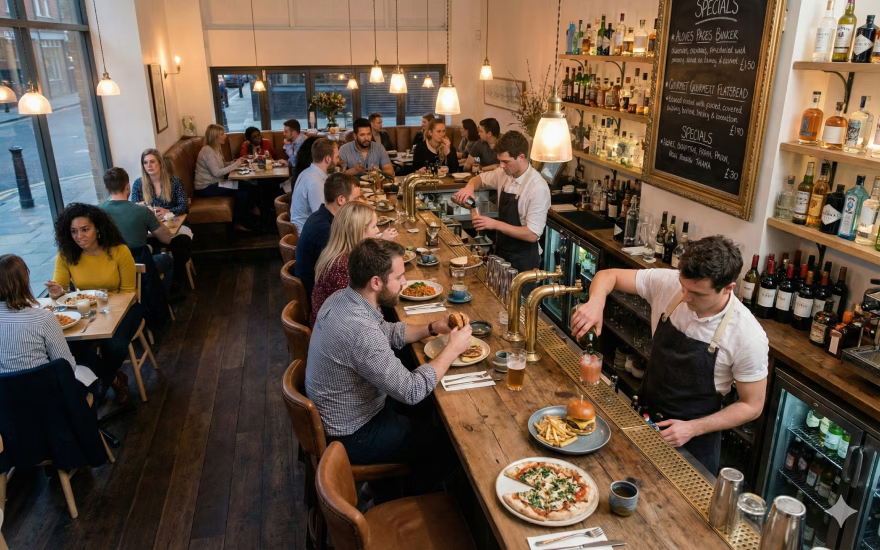Restaurant Chains Are Closing Locations — What’s Going Wrong

In recent months, several well-known restaurant chains have faced significant financial hurdles, leading to widespread closures and, in some cases, bankruptcy filings. Brands once considered staples in the casual dining space are now downsizing or disappearing altogether across North America.
Several prominent restaurant chains are scaling back operations or filing for bankruptcy protection. Red Lobster, TGI Fridays, Noodles & Company, Red Robin, and Jack in the Box are only a few examples of large chains that have announced large-scale closures this year.
A Closer Look at What’s Happening
High Operating Costs
Red Lobster, once a leader in casual dining, filed for Chapter 11 bankruptcy in May 2024, citing struggles with high food costs and a complicated supply chain. Before filing for bankruptcy, the brand launched an “Endless Shrimp” promotion to revive its business. The promotion effectively increased foot traffic, but ultimately resulted in a significant financial loss of $11 million for the company. By closing over 100 locations in 30+ states, upward of 10,000 employees have been affected.
Similarly, TGI Fridays also closed over 100 locations and filed for Chapter 11 bankruptcy in 2024. They have been dealing with rising operational costs, inflation, interest rates, and competition from cheaper fast-dining options. This year, they announced the closure of another 30 underperforming restaurants across the U.S., laying off over 1,000 employees.
Underperforming Locations
Noodles & Company, Red Robin, and Jack in the Box have all announced plans to close underperforming locations in an effort to improve overall financial health. In 2025, Noodles & Company may shutter up to 17 restaurants, Red Robin up to 15, and Jack in the Box as many as 120. These underperforming locations are defined by declining sales, high rent costs, and sometimes outdated facilities that no longer justify continued investment for the brand. By streamlining their operations and focusing on more profitable markets, these chains hope to strengthen their core business and position themselves for long-term survival.
Changing Consumer Preferences
Even before the pandemic, dining habits in North America were shifting as consumers — especially Millennials and Gen Z — began favoring fast-casual restaurants over traditional sit-down dining. With the pandemic, these trends accelerated dramatically as takeout, delivery, and online ordering became the norm for diners of all ages. These evolving trends have reshaped the restaurant industry, as consumers increasingly prioritize convenience, speed, and digital access — transforming how and where they choose to dine. Traditional sit-down restaurant chains like Applebee’s and On The Border Mexican Grill & Cantina are feeling the growing challenges and are actively pivoting to remain viable. This year, On The Border has announced the closure of over 70 locations across the U.S., while Applebee’s has closed more than 300 since 2017—with an additional 30 closures expected by the end of 2025.
These closures and strategic shifts underscore the intense pressure facing the restaurant industry. Survival increasingly hinges not only on adapting to evolving consumer preferences, but also on executing disciplined financial management to remain competitive and profitable.

Is There a Path Forward?
Despite these challenges, some chains are pursuing turnaround strategies:
- Red Lobster’s restructuring includes closing underperforming stores, focusing on international growth, and optimizing core operations.
- TGI Fridays is testing refreshed menus and updated store formats aimed at improving customer experience and profitability.
- Noodles & Company has revamped its menu and has seen revenue increase, rising 2% in the first quarter of 2025, with same-store sales increasing 4.4%.
- Applebee’s parent company, Dine Brands, is getting creative and opened the first Applebee’s-IHOP dual branded restaurant this year. The restaurant features a shared space, separating the dining rooms to maintain each brand’s identity, but allowing diners to enjoy both restaurant’s offerings from one menu.
These efforts reflect a broader industry push to adapt, innovate, and re-engage customers in an increasingly competitive and evolving dining landscape. While the strategies may seem promising, only time will tell if they will lead to sustained success and long-term recovery.

Restaurants Defying the Downturn
While many restaurant chains are grappling with closures and financial challenges, several North American brands are not only surviving — but thriving. Here are a few restaurant chains to keep your eyes on:
1. Shake Shack
Shake Shack is broadening its reach with plans to open 85 new restaurants in 2025, and 10 new casino-based locations in 2026 in partnership with PENN Entertainment. The brand's exploration of flexible restaurant formats, including drive-thrus and smaller-format stores, demonstrates adaptability. Collaborations, such as exclusive in-flight offerings with Delta Airlines, further enhance its market presence.
2. Pür & Simple
Pür & Simple is a restaurant chain specializing exclusively in breakfast and lunch. It has branded itself as a modern, high-quality brunch destination with emphasis on the experience. With a visually appealing, "Instagram-worthy" atmosphere and a menu that resonates with a broad demographic — particularly younger customers — the brand stays relevant by regularly introducing creative and health-conscious dishes that align with current food trends. This year, they celebrated the opening of their 50th Canadian location, marking a major milestone in their “Road to 100” campaign, which aims to establish 100 locations nationwide. Additionally, the brand is set to make its U.S. debut this year with a new location opening in San Antonio, Texas.
3. Chipotle
Chipotle is pushing forward with its aggressive expansion strategy, aiming to open up to 345 new locations this year — many of which will include "Chipotlanes," dedicated drive-thru lanes for digital order pickups. By prioritizing convenience and maintaining a strong commitment to fresh, high-quality ingredients, the brand continues to prosper, with a long-term goal of reaching 7,000 restaurants across the U.S. and Canada
4. Earls Kitchen + Bar
Established in 1982, Earls Kitchen + Bar has grown to 70 locations across Canada and the United States. The brand's enduring success can be attributed to its customized experience, where each location is uniquely designed to reflect the local community's character, avoiding a one-size-fits-all approach. Earls first attempted a U.S. expansion in the late ‘90s, but ultimately failed. With fresh insights, Earls 2.0 launched in 2014, opening a location in Miami. By the end of 2025, Earls is set to have 13 locations operating in the U.S.
5. Chick-fil-A
Chick-fil-A continues its impressive growth, opening 64 new locations in 2025, bringing its total to over 3,200 across the U.S., Puerto Rico, and Canada. The brand's commitment to quality food and exceptional customer service has cultivated a loyal customer base. Its focus on operational efficiency and community engagement further solidifies its position in the market.

How Multi-Location Restaurants Can Succeed
In a market where many restaurant chains are closing their doors, those that are expanding offer valuable insights into what it takes to succeed in today’s challenging environment. What sets these brands apart? They are embracing innovation, staying in tune with consumer demands, and making strategic decisions that drive growth. Here are five key strategies that forward-thinking restaurant owners are using to stand out and build resilience in today’s landscape:
Invest in Workforce Management
Optimize your restaurant’s management with a platform like Push Operations to improve operational efficiencies, stay compliant, and protect margins. Automated labor compliance tools help owners maintain accurate records, avoid penalties, and ensure consistent policies across every location.
Streamline the Menu
Post-pandemic, many successful restaurants have adopted a leaner approach by trimming bloated menus and focusing on bestsellers and high-margin items. This not only improves kitchen efficiency and streamlines operations but also reduces supply chain complexity — an ongoing challenge in the industry. A smart menu design also maximizes ingredient usage, such as incorporating a single versatile vegetable across multiple dishes, helping reduce waste, lower costs, and boost overall profitability without sacrificing variety or quality.
Review Marketing Strategies
Marketing strategies are crucial in the competitive hospitality industry. Effective marketing drives awareness, builds loyalty, and, most importantly, brings guests through the door. Owners should focus on campaigns that offer measurable returns. Social media, in particular, is no longer optional. A consistent and authentic presence on platforms like Instagram and TikTok can amplify visibility and engage customers in real time.
Use Workforce Data to Drive Profitability
Real-time labor data can uncover inefficiencies, forecast demand, and optimize scheduling. Instead of guessing, operators can make informed staffing decisions that reduce overtime, improve compliance, and result in profitable decisions.
Monitor Consumer Behavior
Keep an eye on broader dining trends — such as sustainability and convenience. Mobile ordering and delivery have become a permanent and strategic revenue stream for many restaurants in 2025. Staying in touch with your customers’ values helps you stay relevant.

Looking Ahead: How to Thrive in 2025
Closures can feel discouraging, but they’re also instructive. The restaurant industry is evolving, and now more than ever, owners must pay attention, adapt, and respond strategically to stay competitive and succeed.
At Push Operations, we partner with owners across the restaurant and hospitality space to streamline scheduling, payroll, compliance, and labor insights — all in one smart platform. Whether you're scaling up or rethinking how your business runs, we're here to help you build with confidence. Looking to future-proof your operations? Learn how Push helps multi-location restaurants thrive in the industry.



